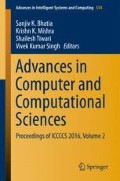Abstract
Prediction of stock movements and share market has always remained an area of great curiosity and concern for investors. It has already been established that the movement of market shares a big correlation with the sentiments about it. In this paper, we have applied sentiments analysis techniques and machine learning principles to foretell the stock market trends of three major commodities, Gold, Silver and Crude oil. We have used the SentiWordNet library to quantify the emotions expressed in the text. Further neural network has been trained over the calculated readings. Thereafter, the trained neural network is used to forecast the future values. The efficacy of the proposed model is measured on the basis of mean absolute percentage error. The results clearly reflect that there in fact lies a strong correlation between public mood and stock market variations.
Access this chapter
Tax calculation will be finalised at checkout
Purchases are for personal use only
References
R. J. Dolan, “Emotion, cognition, and behavior,” Science, vol. 298, no. 5596, pp. 1191–1194, 2002.
E. F. Fama, “The behavior of stock-market prices,” The journal of Business, vol. 38, no. 1, pp. 34–105, 1965.
P. H. Cootner, “The random character of stock market prices,” 1964.
A. Pak and P. Paroubek, “Twitter as a corpus for sentiment analysis and opinion mining.,” in LREc, vol. 10, pp. 1320–1326, 2010.
H. Mao, S. Counts, and J. Bollen, “Predicting financial markets: Comparing survey, news, twitter and search engine data,” arXiv preprint arXiv:1112.1051, 2011.
J. Bollen, H. Mao, and A. Pepe, “Modeling public mood and emotion: Twitter sentiment and socio-economic phenomena.,” ICWSM, vol. 11, pp. 450–453, 2011.
C. Whitelaw, N. Garg, and S. Argamon, “Using appraisal groups for sentiment analysis,” in Proceedings of the 14th ACM international conference on Information and knowledge management, pp. 625–631, ACM, 2005.
B. Pang and L. Lee, “A sentimental education: Sentiment analysis using subjectivity summarization based on minimum cuts,” in Proceedings of the 42nd annual meeting on Association for Computational Linguistics, p. 271, Association for Computational Linguistics, 2004.
N. Godbole, M. Srinivasaiah, and S. Skiena, “Large-scale sentiment analysis for news and blogs.,” ICWSM, vol. 7, no. 21, pp. 219–222, 2007.
E. Kouloumpis, T. Wilson, and J. D. Moore, “Twitter sentiment analysis: The good the bad and the omg!,” Icwsm, vol. 11, pp. 538–541, 2011.
P. Nakov, Z. Kozareva, A. Ritter, S. Rosenthal, V. Stoyanov, and T. Wilson, “Semeval-2013 task 2: Sentiment analysis in twitter,” 2013.
G. Mishne, N. S. Glance, et al., “Predicting movie sales from blogger sentiment.,” in AAAI Spring Symposium: Computational Approaches to Analyzing Weblogs, pp. 155–158, 2006.
J. A. Chevalier and D. Mayzlin, “The effect of word of mouth on sales: Online book reviews,” Journal of marketing research, vol. 43, no. 3, pp. 345–354, 2006.
P. C. Tetlock, “Giving content to investor sentiment: The role of media in the stock market,” The Journal of Finance, vol. 62, no. 3, pp. 1139–1168, 2007.
S. Asur and B. A. Huberman, “Predicting the future with social media,” in Web Intelligence and Intelligent Agent Technology (WI-IAT), 2010 IEEE/WIC/ACM International Conference on, vol. 1, pp. 492–499, IEEE, 2010.
J. R. Nofsinger, “Social mood and financial economics,” The Journal of Behavioral Finance, vol. 6, no. 3, pp. 144–160, 2005.
S. Baccianella, A. Esuli, and F. Sebastiani, “Sentiwordnet 3.0: An enhanced lexical resource for sentiment analysis and opinion mining.,” in LREC, vol. 10, pp. 2200–2204, 2010.
M. T. Hagan and M. B. Menhaj, “Training feedforward networks with the marquardt algorithm,” IEEE transactions on Neural Networks, vol. 5, no. 6, pp. 989–993, 1994.
A. Lapedes and R. Farber, “Nonlinear signal processing using neural networks: Prediction and system modelling,” tech. rep., 1987.
T. Kimoto, K. Asakawa, M. Yoda, and M. Takeoka, “Stock market prediction system with modular neural networks,” in Neural Networks, 1990., 1990 IJCNN International Joint Conference on, pp. 1–6, IEEE, 1990.
X. Zhu, H. Wang, L. Xu, and H. Li, “Predicting stock index increments by neural networks: The role of trading volume under different horizons,” Expert Systems with Applications, vol. 34, no. 4, pp. 3043–3054, 2008.
E. Loper and S. Bird, “Nltk: The natural language toolkit,” in Proceedings of the ACL-02 Workshop on Effective tools and methodologies for teaching natural language processing and computational linguistics-Volume 1, pp. 63–70, Association for Computational Linguistics, 2002.
A. Esuli and F. Sebastiani, “Sentiwordnet: A publicly available lexical resource for opinion mining,” in Proceedings of LREC, vol. 6, pp. 417–422, Citeseer, 2006.
K. Denecke, “Using sentiwordnet for multilingual sentiment analysis,” in Data Engineering Workshop, 2008. ICDEW 2008. IEEE 24th International Conference on, pp. 507–512, IEEE, 2008.
B. Ohana and B. Tierney, “Sentiment classification of reviews using sentiwordnet,” in 9th. IT & T Conference, p. 13, 2009.
Online website, “Silver phoenix 500 (silver-phoenix500.com),” 2016.
Online website, “Gold eagle, empowering investors since, 1997 (gold-eagle.com),” 2016.
Online website, “Stock twits (stocktwits.com),” 2016.
Online website, “New york stock exchange (nyse.com),” 2016.
Author information
Authors and Affiliations
Corresponding author
Editor information
Editors and Affiliations
Rights and permissions
Copyright information
© 2018 Springer Nature Singapore Pte Ltd.
About this paper
Cite this paper
Keshwani, K., Agarwal, P., Kumar, D., Ranvijay (2018). Prediction of Market Movement of Gold, Silver and Crude Oil Using Sentiment Analysis. In: Bhatia, S., Mishra, K., Tiwari, S., Singh, V. (eds) Advances in Computer and Computational Sciences. Advances in Intelligent Systems and Computing, vol 554. Springer, Singapore. https://doi.org/10.1007/978-981-10-3773-3_11
Download citation
DOI: https://doi.org/10.1007/978-981-10-3773-3_11
Published:
Publisher Name: Springer, Singapore
Print ISBN: 978-981-10-3772-6
Online ISBN: 978-981-10-3773-3
eBook Packages: EngineeringEngineering (R0)

